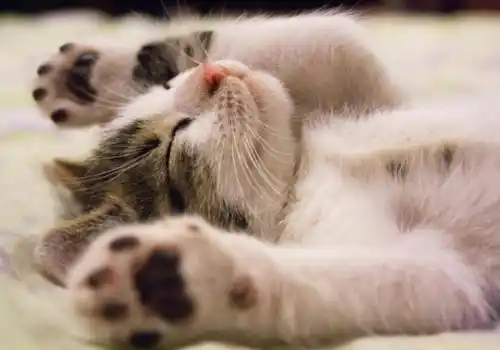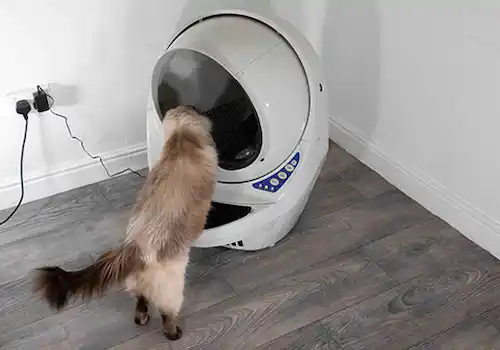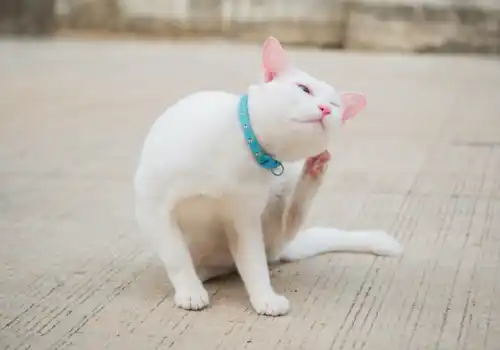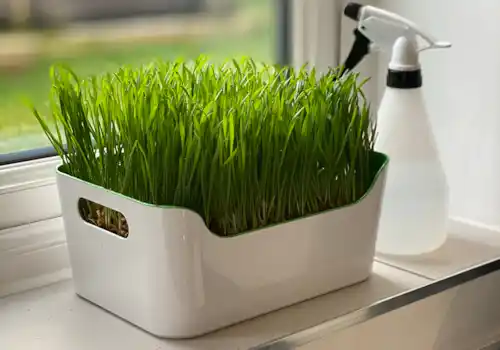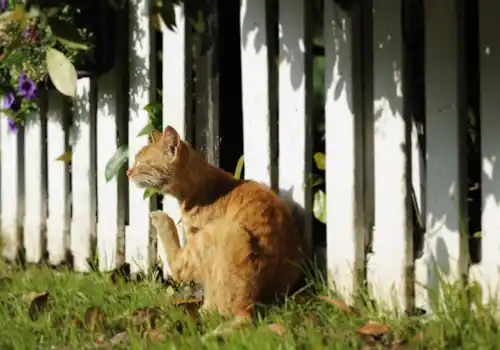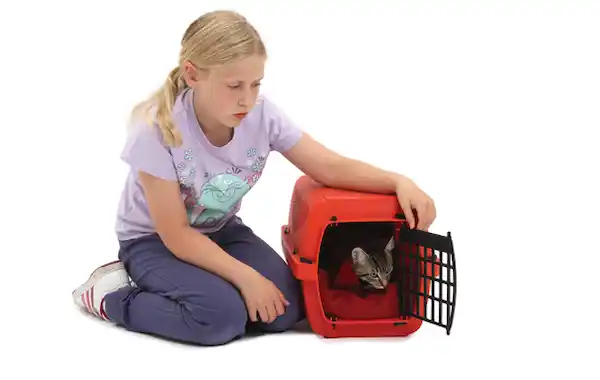Build positive associations with cat carriers for vet visits and trips. Train your cat to use a cat carrier.
In the last article (The training toolbox), we looked at ways of influencing our cats' behaviour through the use of positive reinforcement. These methods comprised capturing - when the cat freely performs the behaviour you desire, you reward him; luring - when you move your reward (a toy, for example) in a manner that encourages your cat to perform what you wish him to do; and shaping - rewarding successive approximations of the final desired behaviour, allowing more complex behaviours to be achieved.
Sitting the cat on the mat
The purpose of teaching a relaxed settle on a mat is to provide a basis from which you can teach other behaviours you may require in order to look after your cat in the most welfare-friendly way you can. The first of these behaviours to be covered in this article is teaching the cat that being in the carrier is a good thing, rather than something to be nervous or fearful of.
A crucial point from our last article is that we are not just teaching our cats to sit or lie on a mat or blanket, but we are teaching them to relax on the mat; that is, we are aiming to reward an emotional state as well as just a posture or behaviour. This is so important as our cats learn that the mat is a positive place to be. Here, we describe how we utilise this mat training in carrier training so that we can transfer that learnt relaxed state to the carrier.
Take a look at your carrier
Before we begin teaching that the mat can move into the carrier and still be positive, there are a number of things we can do to ensure we create positive perceptions of the carrier.
If your cat already has a very negative association with the cat carrier, it is worth taking some time to think why this might be. There are some things you can change about your carrier to make this training process easier.
Why does my cat hate the cat carrier?
Do you think it may be related to the way you put your cat in the carrier? For example, is it a battle to get him in? The first step is to stop any behaviour that involves force to get your cat into the carrier. Therefore, you may want to start the training process when you know you do not have any scheduled appointments at the vets for the next few weeks
If your cat really hates the carrier, it might be worth buying a new carrier of a different model and start the training with this as it will have less association to any negative events attached to carriers
Could the carrier be too small for your cat? Your cat should be able to have enough space in his carrier to stand up and turn around. If this is not the case, it would be advisable to buy a larger carrier
Does it smell of another cat? For example, do all your cats use the same carrier at different times? If this is the case and the cats do not have an amicable relationship, the close proximity to the smell of another cat and the inability to escape from it may be stressful for your cat. In addition, if your other cats do not like going in the carrier either, they may have deposited chemical scents (pheromones) from the pads of their feet and other parts of their body, which communicate that they were anxious while in the carrier. Such a message will make your cats much more wary of the carrier. Therefore it is a good idea to wash down the carrier after use with a warm solution of biological washing powder to remove any of these chemical messages. For this reason (as well as others described later), it is recommended to have a plastic carrier
Does your cat travel in the carrier at the same time as another cat? Even if your cats all get along well in the home, forcing some of them to share a small space from which they cannot escape can create tension and anxiety. Always travel cats separately, so they have a carrier each
Does your cat only ever go in the cat carrier for a trip to the vets or the boarding cattery? This is very commonly the case and if the cat does not enjoy such events, he will simply learn that the carrier predicts that a trip to the vet or cattery is imminent! By ensuring the carrier is accessible in the home at all times (more on this later), we can begin to break down such associations
Could there be some other reason why your cat doesn't like the carrier? For example, does your cat dislike travelling? As for the example above, the carrier is likely to predict travelling and if your cat is not keen on travelling or, more specifically, being in the car, such negative associations can generalise to the carrier itself. We will cover travelling next month where more guidance will be given to help overcome this problem.

'I love my carrier'
After considering the questions above and making the required changes, there are a number of further tips that will help your cat learn to associate the carrier as a positive thing.
The first is to have the carrier out and open (with the door off) in your home all of the time. Make it a cosy, comfortable place in a safe and secure area so that it is as inviting as possible. Place it in a room your cat spends time in and ideally not the room you have previously put the cat into the carrier if it has been a battle in the past. It's a good idea to have a carrier with a forward-facing door so that your cat does not need to jump to get into it.
Spraying a synthetic feline facial pheromone into the carrier (allowing 15 minutes before giving your cat free access to it to allow any alcohol in the product to evaporate) can help your cat's perception that the carrier is a positive place. An alternative is to rub a cloth on your cat's facial area when you are stroking him (only if he enjoys being stroked) then rub this cloth on the outer corners, entrance and inside the carrier. Place things your cat really values in the cat carrier (such as his favourite food treats, catnip or toys) and if he shows any interest in the carrier, reward him using his favourite rewards (see earlier issues). For a cat that has never had any experience of the cat carrier before, such as?a new kitten, this method (luring) may be enough to encourage an explorative kitten into the carrier.
For adult cats with previous experience of the carrier that is neutral or only slightly aversive, having your carrier out in the home all the time with positive things in it may be enough to build up your cat's courage to explore it and see that as soon as he sniffs it, he is not pushed in, door closed and taken out of the home to the car. He can explore and spend time around the carrier at his own leisure.
However, some cats will not be confident enough to do this, particularly those that already are anxious or fearful of the carrier. In addition to doing the above, we can utilise our relaxed mat training (which uses the shaping tool from the last article) to aid confidence and relaxation around and in the carrier.
Back to basics
Most plastic carriers have a bottom part and a top - start the training with the top part of the carrier removed. This makes the carrier appear less enclosed and potentially threatening. Ensure you have already practised your relaxed 'settle on the mat' (see the last article) and begin the session with the mat some distance from the carrier (but within the same room) and reward for relaxed behaviour on the mat. The initial distance between mat and carrier will depend on your cat's current perception of the carrier. If it is very negative, make sure you have a greater distance.
Gradually, over a number of sessions, move the mat closer towards the carrier. Never move the mat while your cat is on it. Since your cat should now be offering relaxed behaviour on the mat, you can mark this with the word 'good' (as shown in the videos) and then provide your chosen reward (toy, food treat or fuss) off the mat. This will allow you to move the mat while your cat is engaged in his reward. Remember to go at a pace your cat is comfortable with, tailoring the length of training session to your cat's engagement and ensuring you always end on a positive note.
Over a number of sessions, gradually move the mat into the carrier. Aim to get to the stage where your cat will relax on the mat in the cat carrier with the top off. At this stage, you can attach the roof. Do this when your cat is not in the carrier. You may need to go back a few steps taking the mat out of the carrier if your cat is not keen to enter into the carrier at this stage with the top on.
Remember to shape the behaviour - for example, your cat may only offer placing his head in the carrier initially. Reward this and gradually build to head and one paw in the carrier, to head and two paws in carrier, to head, front paws and half of body in carrier and so forth. Our final goal is to have the cat's entire body in the carrier and the cat showing relaxed behaviour on the mat in the carrier. Remember at no stage have we had to touch our cat to get him to enter the carrier (unless we are using stroking as our reward!).
Only once you are at this stage and you have practised it several times, with your cat remaining at his own will in the carrier for a prolonged period of time, would it be appropriate to introduce the door of the carrier. Begin by fitting the door in the open position and shutting it for just a second when the cat is relaxed in the carrier, reward this relaxed behaviour and open the door. Build this up very gradually to greater lengths of time with the door shut. Ensuring your cat is displaying relaxed behaviour will ensure he does not panic with the door shut. Feeding him treats through the door is a useful way of rewarding relaxed behaviour in the carrier when the door is closed.

